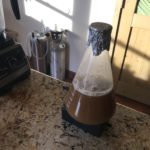It’s fascinating to delve into how things are made. I think they even made a TV show about that, didn’t they? Since we started brewing beer again, we’ve made an effort to try to understand the nuances of how each ingredient modifies the presentation and flavor of the final product.
Beer is really a simple matter. Grain (Malted barley), water, yeast & hops are the only ingredients of beer. Many will tell you that the most important of these four is the yeast. A recent visit to White Labs just north of San Diego impressed upon us just how important a role yeast plays. WL is a leading manufacturer of yeast for brewing here in the USA. While producing yeast for the nations beer in the back room, here’s what they do in the front (tasting) room to present their yeast products to the public. They brew an 80 gallon batch of a particular style beer and divide the batch into 4 – 20 gallon fermenters. They then add a different WL yeast to each fermenter. When you order a beer at their bar, you’ll get 4 small glasses of the same beer, each with a different yeast used during fermentation.
Brewers are frequent visitors to the WL tasting bar as they come to commiserate & wrangle with the difficult decision of which yeast to pitch into their precious beers. Here, you become aware of just how dramatic the differences in flavor that are imparted to the beer by the brewers choice of yeast. If you ever find yourself in San Diego, make the WL tasting room part of your itinerary. You’ll find your self as enlightened as you are inebriated.
In the photo below, I am regrowing yeast purchased last year from White Labs in my kitchen. This is kind of what WL does in their lab under much more sterile conditions. Yeast can be harvested from the bottom of the fermenter after brewing, washed, and regrown to work another batch of beer. This is not just to save a few dollars. Growing your own guarantees that the yeast is fresh and healthy and ready for the hard work ahead. Many older breweries have been regrowing the same strain of yeast for years to maintain and guarantee a consistency in the taste of their beers.
Here, I’ve taken a small sample of yeast from a previous brew and added it to 1.5 liters of wort (basically beer before fermenting). It sits on a stir plate that keeps the wort agitated and oxygenated so the yeast grows rapidly. The foam is a result of the yeast eating complex sugars and releasing carbon dioxide – which really means things are going well and we’re making a lot of new, healthy yeast cells.
Later this weekend, I’ll start a new batch of beer – probably a porter – and what you see in this beaker will be the magic that will tantalize the taste buds of anyone who visits the kitchen in upcoming months. It all starts right here. You already know how it ends.


